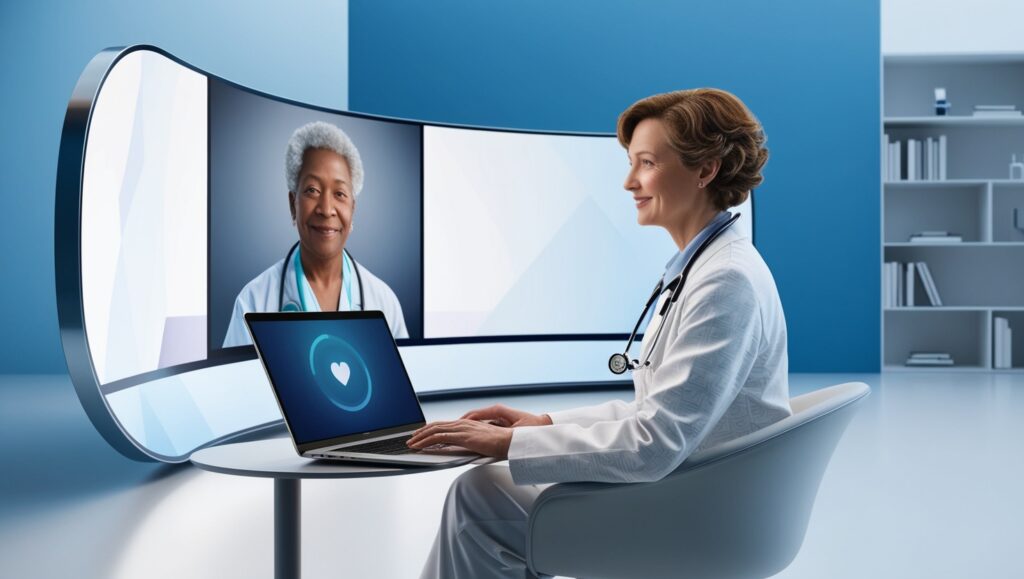Telemedicine and Digital Health: How Technology is Making Healthcare More Accessible and Efficient

In recent years, telemedicine and digital health have revolutionized the healthcare industry, making medical services more accessible, affordable, and efficient. Fueled by advances in technology, rising patient demand, and the global shift brought on by the COVID-19 pandemic, these innovations are transforming how people access and receive care worldwide. From virtual doctor consultations to wearable health devices, telemedicine is breaking down barriers to healthcare like never before.
1. What is Telemedicine and Digital Health?
- Telemedicine refers to the use of digital communication technologies to provide healthcare services remotely. It includes virtual doctor visits, remote patient monitoring, and teleconsultations.
- Digital Health encompasses all technological tools—wearable devices, mobile apps, AI diagnostics, and electronic health records (EHRs)—that improve healthcare delivery and patient outcomes.
Together, these innovations bridge the gap between patients and providers, offering solutions for challenges like limited access to specialists, long wait times, and healthcare costs.
2. How Telemedicine Improves Accessibility
A. Reaching Rural and Underserved Areas
- Telemedicine brings healthcare services to remote and rural regions where access to doctors and hospitals is limited.
- Example: A patient in a rural village can consult a specialist in a major city via video call without the need for travel.
B. Addressing Physician Shortages
- Telemedicine connects patients to doctors worldwide, helping address the shortage of healthcare professionals in certain areas.
C. Convenience for Patients
- Virtual consultations save time and eliminate the need for long commutes or waiting room delays.
- Patients can schedule appointments and receive care from the comfort of their homes.
D. Providing Care for Chronic Illnesses
- Remote monitoring tools enable patients with chronic conditions (e.g., diabetes, hypertension) to share vital signs and receive real-time advice from healthcare providers.

3. How Digital Health Improves Efficiency
A. Virtual Consultations and Teleconsulting
- Platforms like Zoom, Microsoft Teams, and specialized healthcare apps connect patients and doctors virtually.
- Impact: Doctors can see more patients in less time, improving overall efficiency in healthcare delivery.
B. Remote Patient Monitoring (RPM)
- Wearable devices (e.g., Fitbit, Apple Watch) track vital signs like heart rate, blood pressure, and oxygen levels, sending data directly to doctors.
- Example: A patient with heart disease can be monitored remotely, reducing hospital visits while ensuring timely intervention.
C. Electronic Health Records (EHRs)
- Digital health systems allow seamless storage and sharing of patient records among healthcare providers.
- Impact:
- Eliminates paperwork and streamlines diagnosis and treatment.
- Improves coordination between doctors, labs, and pharmacies.
D. AI-Powered Diagnostics
- Artificial Intelligence helps doctors analyze medical data quickly and accurately, reducing human error.
- Example: AI tools analyze radiology images (e.g., X-rays, MRIs) to detect diseases such as cancer at early stages.
4. Benefits of Telemedicine and Digital Health
- Improved Access: Patients in underserved areas can now connect with specialists and access high-quality care.
- Cost Savings: Virtual visits are often cheaper than in-person consultations, reducing travel and operational expenses.
- Time Efficiency: Telemedicine saves both patients and healthcare providers significant time.
- Better Chronic Disease Management: Digital tools enable real-time tracking and personalized treatment adjustments.
- Increased Patient Engagement: Health apps empower individuals to monitor their health, encouraging proactive care.
- Reduced Hospital Strain: Virtual care reduces the burden on hospitals, freeing up resources for emergency cases.
5. Challenges of Telemedicine and Digital Health
While the benefits are substantial, telemedicine faces certain challenges:
A. Digital Divide
- Limited access to technology and reliable internet in rural or low-income areas can exclude patients from telehealth services.
B. Privacy and Data Security
- Sharing medical data digitally raises concerns about security breaches and data privacy.
- Solution: Implementing robust cybersecurity systems and complying with regulations like HIPAA.
C. Limited Physical Examinations
- Some conditions require in-person evaluation, making virtual care insufficient for all cases.
D. Technological Literacy
- Elderly patients or those unfamiliar with technology may struggle with virtual consultations or apps.
6. The Role of Telemedicine During COVID-19
The COVID-19 pandemic accelerated the adoption of telemedicine as it became a lifeline for healthcare systems:
- Virtual consultations replaced in-person visits, minimizing infection risks.
- Hospitals utilized telemedicine for triaging COVID-19 patients and managing mild cases remotely.
- Digital health tools monitored patients in isolation, improving care continuity.
Post-pandemic, telemedicine remains a key component of healthcare delivery, with many patients and providers embracing its long-term benefits.
7. Future Trends in Telemedicine and Digital Health
- AI-Driven Virtual Doctors: AI chatbots will assist with initial consultations, diagnostics, and treatment recommendations.
- Augmented Reality (AR) in Surgery: AR will enable remote guidance for surgeons in real-time.
- 5G Connectivity: Faster internet speeds will improve video consultations, telemonitoring, and data sharing.
- Wearable Health Tech: Smart devices will evolve to provide even more advanced health monitoring, such as glucose levels for diabetics.
- Virtual Hospitals: Entire healthcare services, from diagnosis to treatment, will be provided virtually, reducing the need for physical infrastructure.

8. Conclusion
Telemedicine and digital health represent a new frontier in modern medicine, offering solutions to long-standing healthcare challenges. By enhancing accessibility, efficiency, and patient engagement, technology is reshaping healthcare delivery globally.
While challenges like privacy and the digital divide need to be addressed, the future of telemedicine is promising. As innovations continue to emerge, telehealth will play an increasingly vital role in creating a more equitable, efficient, and patient-centered healthcare system.
The digital healthcare revolution is no longer a distant vision—it’s here to stay, offering hope and care to patients wherever they are.






